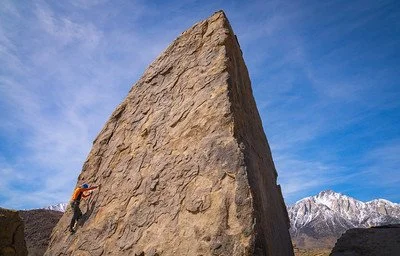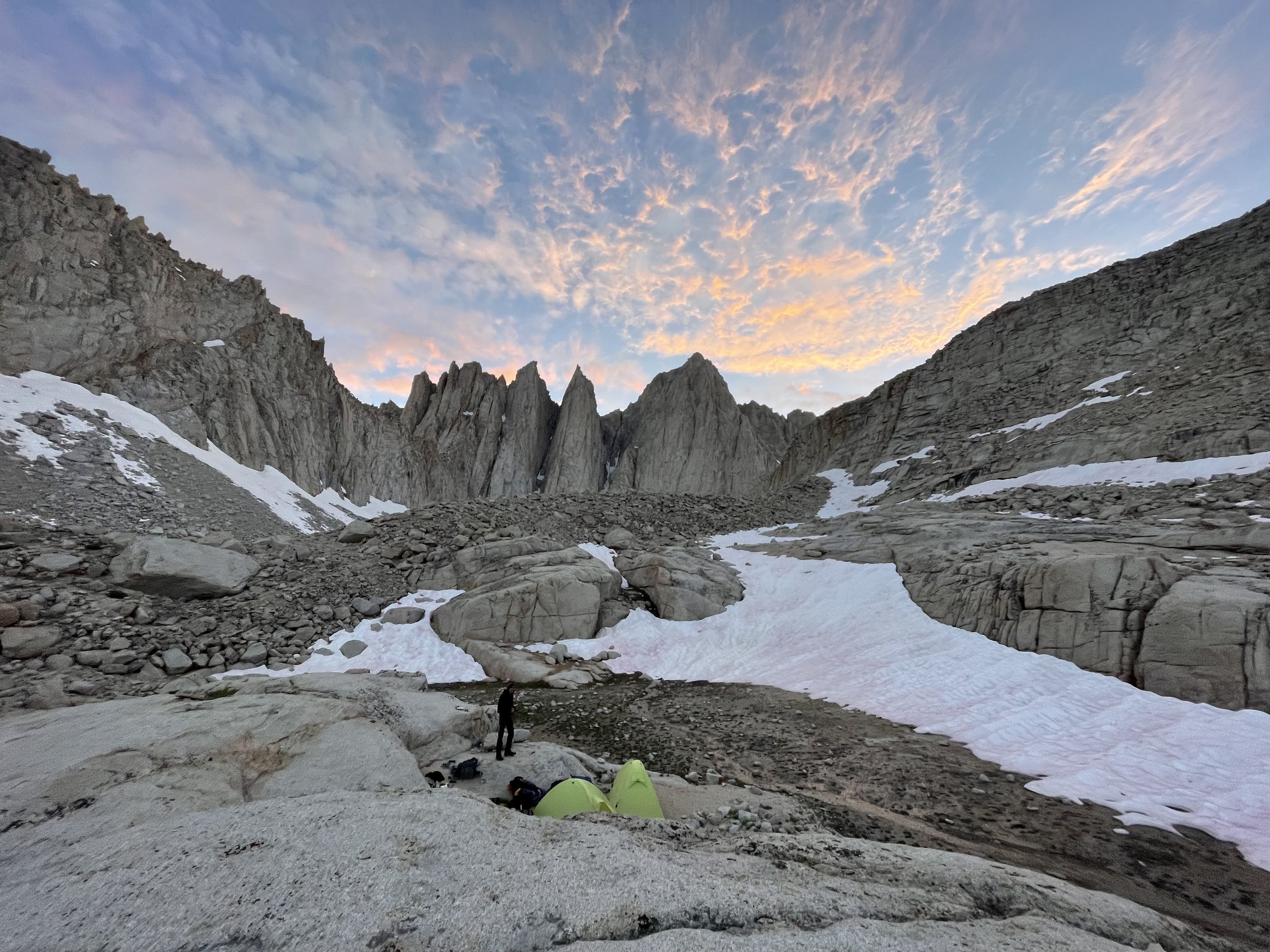Plan Your Climbing Trip To Bishop
The Bishop Chamber of Commerce has some amazing resources for traveling to Bishop. We have selected a few critical pieces relevant to climbers. However, we also recommend checking out bishopvisitor.com and click “Plan your Trip” for more in-depth information.
When to Climb in Bishop
Best Seasons and Crag Conditions:
Owens River Gorge, aka “The Gorge”: Fall, Winter, Early Spring.
Pine Creek: Depending on the amount of snow, this can be a year round climbing area. Crag dependent.
Tablelands (Happy and Sad Boulders): Fall, Winter, Early Spring.
Buttermilk Boulders: Fall, Winter, Early Spring.
Rock Creek: Late Spring, Summer, Early Fall.
The High Sierra: Summer.
Weekends vs Weekdays
Weekends and holidays are extremely busy in the Bishop area. You are more likely to experience less crowded climbing areas if you plan trips during the week and avoid major holidays such as Thanksgiving and New Year's.
Climbing Festivals
Flash Foxy Climbing Fest - a climbing festival, typically in March, for women and genderqueer climbers.
Getting to Bishop
Driving
Most visiting climbers get to Bishop via Highway 395. Sections of 395 may close during the winter due to weather conditions, most commonly in areas between Reno and Bishop. We highly recommend checking Highway 395 - Type in “395” for up-to-date information.
Flights
Fly to Bishop during summer and winter with the newly established flights from United Airlines connecting through San Francisco and Denver. These seasonal flights connect Bishop to the world and open up a world of adventure for visitors to the Eastern Sierra. Flights from San Francisco are only about 30 minutes with a bird’s eye view of Half Dome!
Car Rentals
If you fly into Bishop, it’s best to have someone to pick you up or stick to non-dirt roads in your vehicle rental. Many of the dirt roads, especially in the winter, are rough, and Bishop Enterprise rental cars may not be allowed to be taken to areas like the Buttermilks. Supplies are extremely limited and a reservation is strongly recommended.
Rental cars are also available through Turo - it’s like an airbnb for your car.
Where to Stay
Lodging
There are many hotels, hostels, and places to stay indoors if camping is not your jam. Check out bishopvisitor.com/lodging/ for other accommodations.
Campgrounds
Many campgrounds in the Bishop Area are quite affordable and well-kept. By choosing a campground, you can help minimize your impact. Here are some of our favorites!
PV Pit Campground- This campground has toilets, a shade structure, and great views. It is conveniently located very close to the Happies and the Sads, and isn't a far drive to the Owens River Gorge and Pine Creek. The Pit is open year-round, although it is best Oct-May due to extreme summer temperatures. Long-term camping permits are available at the BLM office, located 351 Pacu Lane, Bishop, Ca 93514. This campgrounds is first-come, first-serve. Cash and credit card payments are available. Free Climbers Coffee some Sundays with the Bishop Climbing Rangers (Oct-May).
Tri-County Fairgrounds - Right in town and within walking distance of stores, restaurants, and bars. Tent camping is $20/night, RV camping is $40/night. The Fairgrounds are pet-friendly and include bathrooms, showers, wi-fi, and access to electricity. Reservations are available.
Brown's Town Campgrounds (5 locations) - $40+/night - bathrooms, showers, pet friendly, RV compatible, laundry on site.
Inyo County Campgrounds (Pleasant Valley) Open year-round and cost $14/ night, with reservations and walk-ins accepted. There are no hookups at these campgrounds. Visit inyocounty.us for more info!
Wanaaha Casino RV Park: Getting in late? Open 24 hours and managed by the Paiute tribe, California's largest Native casino offers RV parking for $25-$60, depending on the date.
Minimal Impact Camping
It is recommended that you use an established campground due to the delicate nature of the ecosystem. If you choose to forgo a campground and choose to disperse camp, this involves a lot more responsibility and diligence. It is important that you park and camp only in areas that have already been impacted and follow the below guidelines to minimize further degradation.
Don’t Crush the Brush! Tents, vehicles, kitchens, and other camping equipment should be placed on bare ground and not on plants.
Campfires: No live or down vegetation may be burned - purchase wood locally. Campfires need to be put out cold to the touch. Use only established campfire rings and do not expand or modify the rings. Free campfire permits are required for propane stoves, grills, and campfires, even in campgrounds. Get your free permit HERE. Campfire restrictions may go into effect at any time, check with land management HERE or call BLM Bishop Field Office: 760-872-5000, Inyo National Forest: 760-873-2400.
Human Waste: Please use a porta-potty or back out your solid human waste and toilet paper using a portable waste system. (RV toilet, WAG bag, etc.).
Pack it in, pack it out: This includes all trash, dog waste, and human waste.
Stay limit: 14 days in a calendar year within the BLM Field Office boundaries. USFS 28 days in a calendar year per district. There is no camping on LADWP land.
Please be considerate of other visitors and reduce noise and light pollution at night.
For more information about dispersed camping in the Eastern Sierra, check out the Camp Like a Pro website and app or the Visit Bishop website.
Local Conditions
Conditions Reports
The Climbing Rangers post weekly conditions reports from October to May. These reports are available on the Visit Bishop Climbing Conditions Report Blog and Instagram.
Alabama Hills
Photo by Jesse Pluim, BLM.
In 2019, the Alabama Hills became a National Scenic Area, one of ten in the nation. Climbing hasn’t changed much and access to climbing has increased! There are a limited number of designated dispersed campsites in the Hills. We recommend staying at the Tuttle Creek Campground for just $10/night (fire ring, toilets, food lockers, great views, cell service). For more information, please visit ESIA’s Alabama Hills Page.
Wilderness Permits
Mount Whitney Zone: Regardless of overnight or day use, a permit is required to enter the Whitney Zone, which includes but is not limited to Mount Whitney, Keeler Needle, and Mount Russell. WAG bags are required in this zone.
Chase Leary Photo
Overnight Wilderness Camping: Requires a permit and minimal impact camping practices. More information about wilderness camping:


